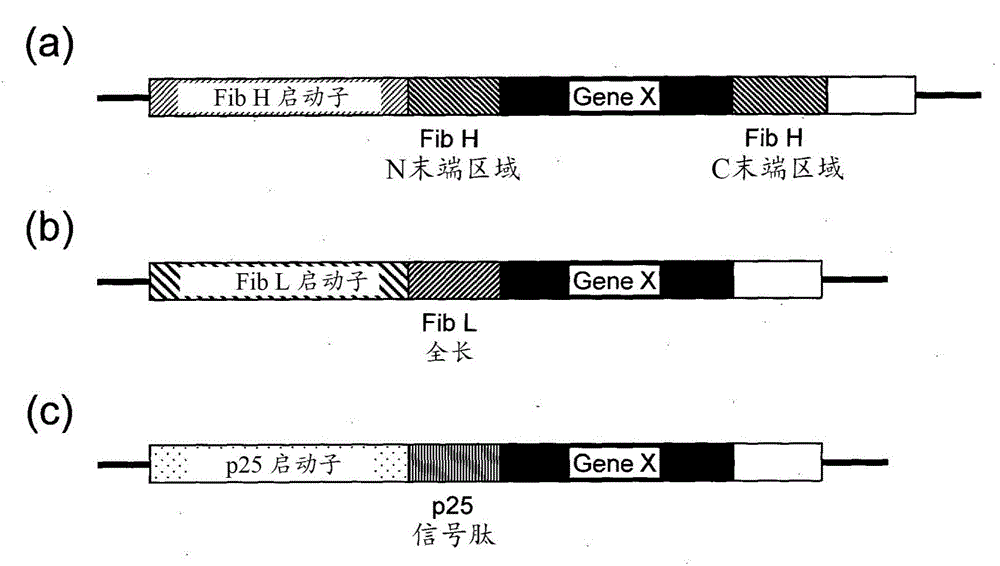Posterior silk gland gene expression unit and transgenic silkworm containing same
A technology of gene expression and silk gland, applied in animal/human peptides, animal husbandry, peptide sources, etc., can solve the problems of low expression and secretion efficiency
- Summary
- Abstract
- Description
- Claims
- Application Information
AI Technical Summary
Problems solved by technology
Method used
Image
Examples
Embodiment 1
[0137]
[0138] Various expression vectors containing the posterior silk gland gene expression unit of the present invention were constructed. In this example, expression vectors such as the posterior silk gland gene expression unit composed of the first and second subunits were constructed.
[0139] (method)
[0140] 1. Construction of expression vector
[0141] (1) The first auxiliary unit for the middle silk gland gene expression unit: pBacSer-pro GAL4 / 3xP3DsRed2 ( Figure 4 (a))
[0142] The first auxiliary unit for the middle silk gland gene expression unit as a control, the promoter of the sericin 1 gene specifically expressed in the middle silk gland and the transcriptional regulator functionally linked downstream thereof were constructed GAL4 gene, and pBacSer-pro GAL4 / 3xP3DsRed2 with hsp70 polyA addition sequence linked downstream.
[0143] Using the primers containing the restriction enzyme AscI site shown in SEQ ID NO: 12 and the primer containing the BamHI si...
Embodiment 2
[0151]
[0152] Various transgenic silkworms were produced using each expression vector constructed in Example 1.
[0153] (Materials and methods)
[0154] (1) Silkworm strains
[0155]The w1-pnd strain of white eye, white egg, non-dormant strain maintained at the Institute of Agricultural Bioresources was used as a host strain.
[0156] (2) Feeding conditions
[0157] In a rearing room at 25 to 27° C., the whole instar larvae were reared with an artificial diet (SilkMate original species 1-3 instar S, Nippon Agricultural Industries). The artificial feed was replaced every 2-3 days (Uchino K. et al., 2006, J Insect Biotechnol Sericol, 75:89-97).
[0158] (3) Production of transgenic silkworm
[0159] Transgenic silkworms were produced according to the method of Tamura et al. (Tamura T. et al., 2000, Nature Biotechnology, 18, 81-84).
[0160] The posterior silk gland gene expression unit constructed in embodiment 1 is used respectively with the auxiliary plasmid pHA3PIG ...
Embodiment 3
[0161]
[0162] (method)
[0163] Each of the transgenic silkworms produced in Example 2 was reared in the same manner as in Example 2. Before silk spinning on the 5th instar and 6th day, mochi was applied on ice, and the back side was incised, and the middle and rear parts were not damaged with tweezers. The method of silk gland removal (refer to Yasushi Mori, カイコによるNew Biology 実験, Sanseido, 1970, pp.249-255). It was observed with a fluorescence microscope (OLYMPUS SZX16, GFP filter) without fixing it.
[0164] (result)
[0165] Figure 5 Indicates the result. In the silk gland of the recombinant silkworm having the middle silk gland gene expression unit, fluorescence was only observed in the middle silk gland. On the other hand, in the silk gland of the recombinant silkworm having the posterior silk gland gene expression unit, fluorescence was observed in both the posterior silk gland and the middle silk gland. This result shows that after EGFP is expressed in the pos...
PUM
 Login to View More
Login to View More Abstract
Description
Claims
Application Information
 Login to View More
Login to View More - R&D
- Intellectual Property
- Life Sciences
- Materials
- Tech Scout
- Unparalleled Data Quality
- Higher Quality Content
- 60% Fewer Hallucinations
Browse by: Latest US Patents, China's latest patents, Technical Efficacy Thesaurus, Application Domain, Technology Topic, Popular Technical Reports.
© 2025 PatSnap. All rights reserved.Legal|Privacy policy|Modern Slavery Act Transparency Statement|Sitemap|About US| Contact US: help@patsnap.com



